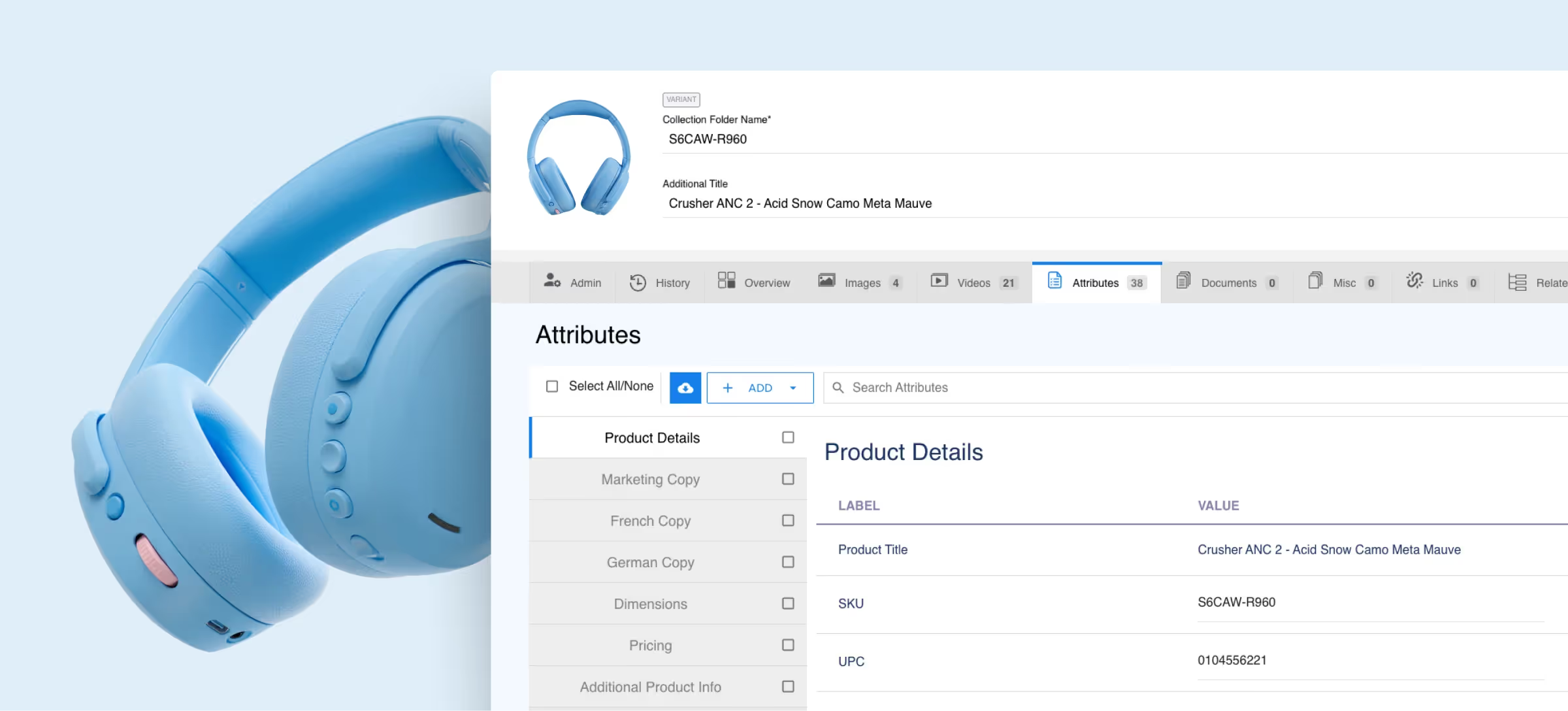The Complete Guide to Product Master Data Management
Product Master Data Management (PMDM) keeps product data accurate, consistent, and easily accessible across a business, helping to boost efficiency, compliance, and customer experience.
What Is Product Master Data Management (PMDM)?
Product Master Data Management (PMDM) is the backbone of organized, reliable product data. It brings all critical product information—descriptions, specifications, pricing, images, and other key attributes—into one central system, ensuring everything stays accurate, consistent, and up to date.
With PMDM, your business can eliminate data silos, reduce errors, and create a single source of truth. This enables smoother operations, better decision-making, and seamless customer experiences. In short, PMDM keeps product data in check so the business runs smarter.
The Importance of Product Master Data Management
When product data is accurate and centralized, everything runs smoother. Teams make better decisions and avoid costly mistakes. Operations become more efficient. Suppliers get the right information the first time, reducing delays and miscommunications.
A master data management framework serves as a single source of truth, and PMDM ensures marketing, sales, supply chain, and customer service all have reliable, up-to-date information. This strengthens brand consistency and enhances the customer experience, making interactions more cohesive and increasing trust at every touchpoint.
The Benefits of Implementing PMDM
- Increased Consistency Across Channels: Product details often vary between a website, marketplace, and sales catalog. PMDM eliminates this problem by keeping product data uniform across marketing, ecommerce, and sales platforms, so customers always see the right information.
- Enhanced Customer Experience: When shoppers get accurate, up-to-date product details, they trust your brand more. No more frustration over mismatched specs or outdated pricing—just a smooth, confident buying experience.
- Effortless Regulatory Compliance: Keeping up with industry regulations can be a headache, but PMDM makes it easier by centralizing and standardizing data. This way, compliance is built-in rather than an afterthought.
- Increased Operational Efficiency: Say goodbye to manual data entry and endless corrections. PMDM reduces errors and eliminates redundancy, freeing up teams to focus on more strategic work instead of fixing avoidable mistakes.
- Better Decision-Making: Reliable, well-organized data gives leadership and teams the insights needed to make smart, informed decisions about optimizing pricing, managing inventory, or launching new products.
How to Implement PMDM Successfully
Adopting PMDM is a strategic journey that requires careful planning. A step-by-step approach ensures smooth integration and long-term success.
Here's how to get started:
1. Assess Current Data Landscape
Before implementing PMDM, conduct a thorough assessment of your existing product data infrastructure.
✅ Inventory Existing Systems: Identify all systems, databases, and applications that store product data (ERP, CRM, ecommerce platforms, spreadsheets, etc.). Understand how these systems interact and where data duplication or inconsistencies occur.
✅ Evaluate Data Sources: List all internal and external sources that feed into your product data (suppliers, manufacturers, marketing teams, etc.). Determine how data is collected, updated, and shared across teams.
✅ Analyze Data Quality Issues: Check for common data quality issues like inconsistencies, missing attributes, outdated information, duplicate entries, or formatting errors. Assess the impact of poor data quality on operations, customer experience, and decision-making.
2. Define Data Standards
Establish clear data governance rules to ensure consistency and prevent future data issues.
✅ Standardize Naming Conventions and Formats: Define a consistent naming structure for product SKUs, descriptions, and attributes. Create uniform formats for unit measurements, categories, pricing, and product specifications.
✅ Identify Mandatory and Optional Attributes: Determine which product attributes are required (e.g., product name, price, weight, dimensions, UPC code, images, descriptions, etc.). Ensure each product record has all necessary fields filled before it can be used in business operations.
✅ Data Validation Rules: Set up validation criteria to prevent incorrect or incomplete entries from being entered into the system. Implement automated checks to flag duplicate or conflicting records.
3. Select the Right Tools
Choosing the right PMDM software is critical to success.
✅ Consider Business Needs and Scalability: Choose a solution that aligns with your organization’s size, industry, and future growth plans. Ensure the platform can handle increasing product SKUs and integrate with other enterprise systems.
✅ Look for Key Features
- Centralized Data Repository: Enables a single source of truth for all product information.
- Data Cleansing and Enrichment: Helps automate de-duplication and data standardization.
- Integration Capabilities: Connects with ERP, CRM, PIM, and ecommerce platforms.
- Role-Based Access Control: Ensures only authorized users can modify product data.
- Analytics and Reporting: Provides insights into data accuracy, completeness, and performance.
✅ Evaluate Deployment Options
- Cloud-Based PMDM (e.g., Informatica MDM, Stibo Systems, Syndigo) for flexibility and scalability.
- On-Premise Solutions for organizations needing greater control over their data.
4. Data Migration and Integration
Migrating product data into a new PMDM system must be done strategically to ensure accuracy and continuity.
✅ Data Mapping and Cleansing: Identify overlapping records and standardize existing data before migration. Cleanse data by removing duplicates, fixing inconsistencies, and enriching missing values.
✅ Develop a Migration Plan: Determine whether data will be migrated in phases or all at once (big bang vs. incremental approach). Conduct pilot migrations with a small subset of data before full-scale deployment.
✅ Integrate with Existing Systems: Ensure seamless integration with ERP, CRM, supply chain systems, ecommerce platforms, and other third-party solutions. Establish real-time or batch synchronization to keep product data updated across all channels.
5. Governance and Maintenance
Once PMDM is live, continuous monitoring and governance are required to maintain data quality.
✅ Establish Data Governance Policies: Define ownership roles (e.g., Data Stewards, Data Managers) responsible for data accuracy. Set up approval workflows for adding or modifying product records. Enforce audit trails to track changes in product data.
✅ Monitor Data Quality Regularly: Implement data quality dashboards to track accuracy, completeness, and consistency. Set up automated alerts for missing or incorrect data entries.
✅ Periodic Data Audits: Conduct scheduled reviews of product data to prevent outdated or incorrect information. Reassess data governance rules as business needs evolve.
Don’t forget the importance of executive support, collaboration between teams, and clearly defined KPIs. Executive support is crucial for driving the initiative forward, while cross-functional collaboration helps align goals and processes. Likewise, clear KPIs help track progress, making it easier to measure success and adjust strategies when needed.
Ready to implement PMDM? Check out Pattern’s tools to get started today.
Best Practices of PMDM
- Establish Clear Data Governance: Make sure everyone understands their role in managing and maintaining data accuracy. Setting clear policies helps ensure consistency and avoid confusion.
- Automate Workflows Where Possible: Take advantage of integrations and AI tools to reduce the chances of human error. Automation speeds up processes and frees up your team for more strategic work.
- Regular Data Audits: Set aside time for periodic data reviews to ensure accuracy and compliance. Regular checks help catch any issues early, preventing larger problems down the road.
- Cross-functional Collaboration: Involve key teams like IT, marketing, supply chain, and sales to make sure all departments are aligned. Collaboration helps streamline decision-making and keeps the project on track.
- Scalability and Future-proofing: Think ahead about how your systems will handle growth, like adding new channels. By planning for the future, you’ll be able to seamlessly scale data management with your business needs.
Product MDM vs. Product Information Management
Master Data Management (MDM) focuses on ensuring accurate, consistent data governance across the entire enterprise, from finance to HR. Product Information Management (PIM), on the other hand, enriches product content specifically for marketing and ecommerce platforms, like product descriptions, images, and specs.
PMDM is broader in scope, combining the strengths of both processes. It covers various data domains—like product, customer, and supplier data—while enforcing quality standards.
For example, PMDM ensures that product details such as descriptions, prices, and specifications are accurate and standardized across the organization, while PIM takes that data and enhances it with additional content like images, videos, and marketing copy for ecommerce platforms.
Together, PMDM and PIM complement each other by ensuring that product data is not only accurate and reliable but also compelling and engaging for customers.
Use Cases: Buy-Side, Inside, and Sell-Side
Effective product master data management (PMDM) keeps everything in sync across the entire supply chain, from procurement to sales. By managing product data at every stage, you create better experiences for everyone, inside and outside the company.
- Buy-Side: When you manage supplier data well, procurement teams can make smarter choices, control costs, and keep supplier relationships running smoothly. With accurate, centralized data, you can avoid mistakes and find ways to save.
- Inside: Having the right product data helps internal teams keep track of inventory, streamline supply chain operations, and work better together. Centralized data gives everyone the visibility needed to make quick, coordinated decisions.
- Sell-Side: Accurate product listings with consistent pricing and details make a big difference in customer trust and conversion rates. With PMDM, marketing and ecommerce teams can present a unified and reliable brand experience across all channels.
Your Roadmap to PMDM Success
Product master data management (PMDM) isn’t just about organizing information—it’s the key to better decision-making, enhanced customer relationships, faster time-to-market, and so much more.
With a well-structured PMDM strategy, you can reduce costly errors, eliminate redundancies, and gain real-time insights that drive growth. It ensures all your departments work with the most accurate, up-to-date data, improving collaboration and agility.
Patterns Master Data Management Solution
It’s time to take control of your product data, streamline operations, and—most importantly—keep customers happy. Accelerate your success today with Pattern’s master data management solution.

Frequently Asked Questions
How does Product MDM differ from Customer or other MDM domains?
Product MDM focuses on managing and maintaining accurate product-related data, such as descriptions, specifications, pricing, and supplier details. Other MDM domains handle data related to people, such as customer profiles and interactions. While they all support data consistency, Product MDM is all about keeping product information clean, organized, and usable across the business.
What are the main components of a PMDM strategy?
A successful PMDM strategy calls for clear data governance, standardized data formats, and seamless system integrations. It also involves automation to reduce manual errors, regular audits to maintain accuracy, and collaboration across departments like procurement, sales, and marketing. Ultimately, the goal is to ensure product data is reliable, accessible, and scalable as the business grows.
What challenges do organizations face when implementing PMDM?
Common roadblocks include messy legacy data, lack of executive buy-in, and resistance to change from teams used to old processes. Integration with existing systems can also be challenging without the right tools. Successful implementation requires strong leadership support, cross-functional collaboration, and a clear roadmap for implementation.
How does PMDM integrate with other enterprise systems?
PMDM connects with ERP, PIM, CRM, and ecommerce platforms to ensure product data stays consistent across the entire business. It streamlines procurement, inventory management, and customer-facing content, making sure every system pulls from the same accurate data. This integration eliminates data silos and keeps operations running smoothly.


.jpg)










